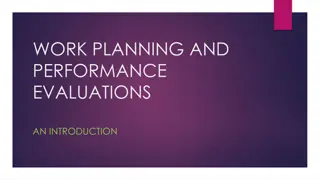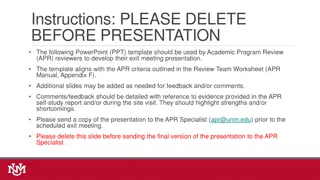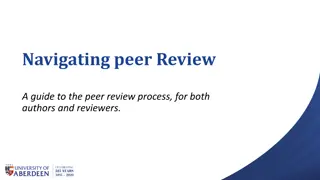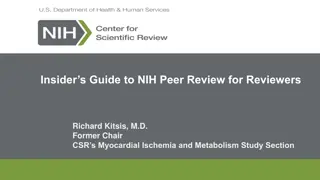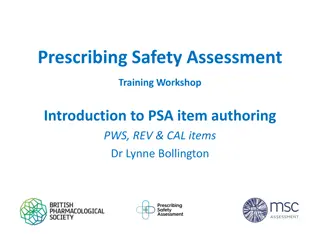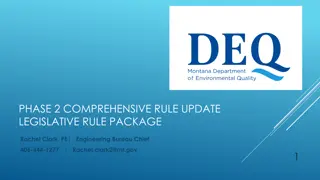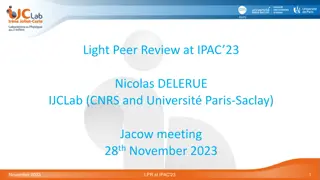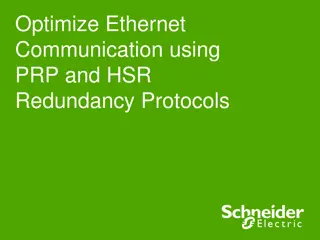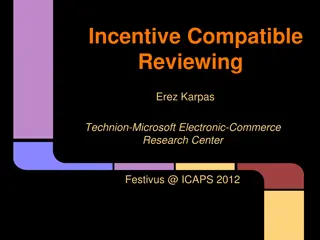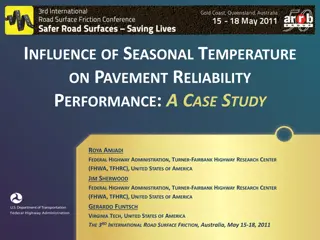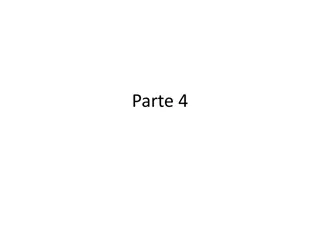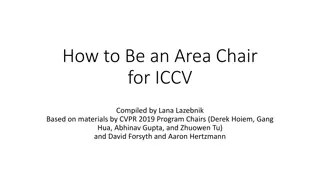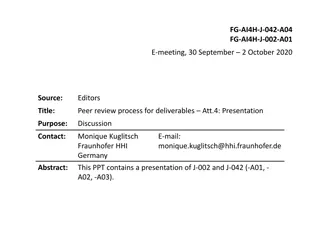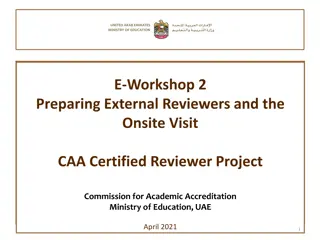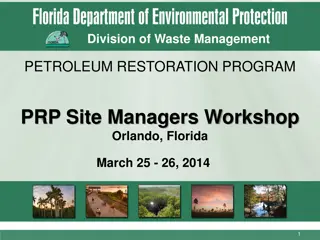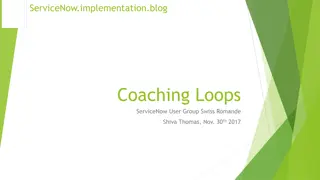Performance Review Process (PRP) Guide for Reviewers - Overview and Tips
This guide aims to assist line managers and reviewers in preparing for performance review meetings. It covers the objectives of the CRGPA performance review process, key stages in the process, discussion areas, top tips for planning, and an overview of the performance review process. Emphasizing on holistic staff performance management, the PRP enables professional dialogue, supports sustainability, sets objectives, identifies development needs, and fosters a culture of trust and openness through meaningful conversations.
Download Presentation

Please find below an Image/Link to download the presentation.
The content on the website is provided AS IS for your information and personal use only. It may not be sold, licensed, or shared on other websites without obtaining consent from the author. Download presentation by click this link. If you encounter any issues during the download, it is possible that the publisher has removed the file from their server.
E N D
Presentation Transcript
PERFORMANCE REVIEW PROCESS (PRP) Reviewer s Guide July 2021
WELCOME TO PRP GUIDE FOR REVIEWERS This guide is developed for line managers and reviewers to help prepare for performance review meetings.
IN THIS GUIDE, YOU WILL FIND: 1) Section One Introduction overview of the objectives of the CRGPA performance review process 2) Section Two what Performance Review Process is? Key stages to the performance review meeting 3) Section Three Meaningful Performance Review Process discussion Areas to consider talking about, setting SMART objectives and identifying development needs. 4) Section Four Top tips Ten top tips to help you plan and prepare for the performance review meeting. 5) Section Five The Performance Review Process A quick overview of the performance review process, including pre-meeting, the meeting and the ongoing actions.
01 INTRODUCTION Taking a holistic approach to managing staff performance, the Performance Review Process enables all staff to establish a professional dialogue with their line manager / reviewer. A performance review looks at wellbeing, performance, achievements, development needs and aspirations of all staff members. The process also promotes continuous performance improvement, self-assessment and personal development, with the aim of enabling staff to achieve high levels of performance, job satisfaction, morale and motivation.
Review achievement of agreed objectives from the previous year. The performance review process supports the sustainability and enhances the organisation s performance in order to achieve it s strategic goals and objectives. Set agreed objectives for the forthcoming year Support achievement of high standards of performance Identify learning and development needs Provide coaching and support to staff looking to develop their careers Underpin improvements in staff performance Cascade organisational strategic and operational objectives.
Cultivate a culture of trust and openness through genuine two-way conversation and reflection. A meaningful performance review process is of significant importance to every individual, their team leaders, managers, team members, departments and the organisation overall. Leaders, managers and team leaders skilled in good questioning and active listening techniques they find out what is going right and what needs improving, and are better able to support their staff. Employees that are aligned to organisation s objectives they understand and appreciate their purpose and contribution. Responsibility for one s own performance and development This emphasis is essentially forward looking, developmental and supportive of progress and development. Increased levels of employee engagement it gives individuals time to talk about them as a person, to be asked how are things going? , to be listened and thanked.
BENEFITS OF PERFORMANCE REVIEW PROCESS Benefits to the Individual Benefits to the Department Benefits to the Alliance Receive recognition and praise An honest and constructive discussion Discuss development needs and aspirations Provide clarity on the employee s role within the team. Discuss organisational change and the impact on the individual Align the employee s contribution and goals with those of the team, department and the organisation. Reflect on performance and identify areas of improvement. Plan for personal and professional development. Identify appropriate objectives for each individual which support departmental plans. Review achievement of objectives in order to improve and optimise team and individual performance. Review and acknowledge progress towards departmental goals, and to recognise and celebrate team successes. Improve communication and clarity of departmental and organisation s goals to help build confidence and mutual understanding. Aid resource planning Gain commitment of team member to the department s goals and plans. Ensure departmental and individual objectives are aligned to the organisation s objectives. Support the process of continuous improvement. Review progress made against strategic goals. Aid resource planning Gain commitment to the organisation s values and strategic direction.
UNDERSTANDING THE IMPORTANCE OF PERFORMANCE REVIEW PROCESS It is not an optional process, and refusal to take part in performance review process could in some cases result in formal actions taken against individuals. If some individuals find this a daunting process, remind them of the purpose and benefits of PRP and reassure them that this is a constructive and supportive process.
GENERAL MISCONCEPTIONS ABOUT PERFORMANCE REVIEW PROCESS It is not a disciplinary or a grievance process. These are separate processes. There can be conversations about an aspect of an employee s work that is not going well, however in a performance review meeting, the employee and manager discuss and agree ways to strike improvement in those areas. Interrogation by line manager / reviewer it is about discussion and equal sharing of ideas. If the process is followed well, it will probably be the employee doing most of the talking rather than the reviewer. PRP is not about venting feelings about line managers, colleagues, departments or the organisation. If the employee has any problems with these, then it should have been shared constructively, at an earlier discussion and not raised in the performance review meeting. The principle of no surprises can ensure that no issue raised at the meeting is new to either party. PRP is not only for those with career ambitions some employees may just be happy to attend work, do a good job and go home. They still have a valuable contribution to make and may need some sort of development. They also need to know which direction the organisation is heading and what their day job contributes to those objectives.
02 WHAT IS PERFORMANCE REVIEW PROCESS Performance review process ensures that any aspects of an employee s work that might have gone less well are dealt with openly and honestly, and that they receive constructive feedback and support, together with the recognition and encouragement they deserve when things are going well.
Looking back and reflecting encourage the employee to talk about how the last year/quarter has gone. What went well? what went less well? what got in the way of them doing their job, and what helped? What could be changed to improve the way they do things? THREE STEP APPROACH Looking forward and planning encourage the individual to talk about what they would like to focus on going forward. Ask them to suggest work or development themselves. objectives for Career development discussions talk about the individuals future, aims, goals and career aspirations. What are their development needs and how can the organisation support them in meeting these? remember, needs can be met in many different ways and not just through training.
03 MEANINGFUL PERFORMANCE REVIEW DISCUSSION The performance review process is made up of the following areas ( it is not an exhaustive list, but should be used as a basis to form a meaningful performance review discussion) EMPLOYEE WELLBEING CHECK, WORKLOAD AND CONCERNS GENERAL FUTURE PLANS, AIMS AND ASPIRATIONS PROPOSED OBJECTIVES FOR THE YEAR AHEAD PROPOSED LEARNING AND DEVELOPMENT NEEDS. PERFORMANCE FOR THE PERIOD UNDER REVIEW
How well has the employee contributed towards the organisation s objective and its values? How has the employee performed against their job description? REVIEW OF GENERAL PERFORMANCE What has the employee achieved and accomplished in addition to objectives? What challenges has the employee experienced? This includes obstacles, changes and other related issues. What are the areas of performance where there is opportunity for growth? Use real examples to help the employee understand the opportunity for improvement.
Is there any specific training which would assist in the employee meeting their future plans, aims and aspirations (e.g. mentoring)? How can you support the employee in meeting their future plans, aims and aspirations? FUTURE PLANS, AIMS AND ASPIRATIONS What other learning or development interventions could be used to develop the employee (e.g. project work)? Is there a need for formal CPD?
How can the employee contribute to strategic plans, reflecting their job role and grade? What are the priorities, opportunities, changes and challenges? FUTURE OBJECTIVES How will these SMART objectives fit in with the employee s future plans, aims and aspirations?
LEARNING AND DEVELOPMENT How has the employee applied what they have learnt to their overall job role and career development? What future development is required for the employee to meet their SMART objectives, future plans, aims and aspirations?
SETTING SMART OBJECTIVES It is important that those involved in setting SMART objectives get the process right, as poorly developed objectives can lead individuals, teams, departments or the whole organisation in the wrong direction. SMART objectives should be based on the organisation s strategy and aligned with it s mission, vision and core values.
WHAT IS SMART OBJECTIVES? The SMART acronym is a tool designed to help organisations and individuals set objectives in an effective and productive manner. Specific and Measurable objectives define the success of a project, initiative, task or activity. Achievable and Realistic objectives engage and motivate individuals. Time-bound objectives ensure that all stakeholders agree time scales for the achievement of objectives.
SETTING SMART OBJECTIVES Identify key strategic areas for focus for your department/service consider the priorities, opportunities, changes and challenges. Key priorities considering roles and levels consider how the employee could make contribution reflecting on their job role and level. Key areas of interest consider employee s career development aims and opportunities (e.g. progression and other development) Format into SMART objectives structured in a clear and concise way and are useful way of gaining agreement and setting expectations for what is achievable. Discussing and agreeing objectives as a result of the PR meeting, objectives are discussed and agreed for the next review period. Working with objectives progress against objectives will form part of ongoing 1-2-1s or team meetings.
PLANNING LEARNING AND DEVELOPMENT What can be classed as a development need ? A development need could also arise as a result of a change in job/work area, or due to future changes to service/demand/working conditions. It is important that employees take ownership of and responsibility for making their development happen. Line manager / review should look at the development need and establish what resources/funds are available to support the employee in this. a gap in an employee s skills or knowledge An area that could be developed to support the employee in achieving their work goals, improve their contribution and/or to fulfil their potential and career aspirations.
Understand the skills and expertise needed by employees and teams to achieve priorities and objectives Understand Identify any skills, knowledge and behaviour gaps that are essential to enable and support employees to carry out their job roles effectively, now and in the future. Identify Think about what learning and development methods may be available. Remember, it does not always have to be through a training course. Think about REVIEWER S RESPONSIBILITY Discuss and agree IS TO: Discuss and agree the learning and development need(s) with the employee. Support essential learning and development activities, considering the provision of time and budget. Support Ensure the application of new skills, knowledge and behaviours in the employee s work practice through support and monitoring. Ensure
ScheduleAgree a date and time for review meeting, allow sufficient time for preparation. Refresh refresh your memory of the PR process. it is incumbent upon you to ensure that you conduct PR meetings in a fair and consistent manner and manage employees expectations. Talk to the individual if it s a first PR meeting, talk the employee through the process and purpose of the process. 04 Reassure PRP can be daunting to some. Ensure they have the opportunity to ask questions prior to their meeting. TOP TIPS Gather information consider the employee s development, contributions and achievements during the period under review. TO Look at the future consider future SMART objectives and development needs, to be discussed with the employee. PREPARE FOR PR MEETING Anticipate any potential for conflict and think how you will handle this. No surprises principle of no surprises do not raise any concerns with the employee if these have not been discussed previously. No interruptions book an appropriate room for the meeting, one that ensures there will be no interruptions. Strategy ensure you are familiar with team/department/organisation s strategic plans. How can the employee contribute to the success of these?
05 THE PERFORMANCE REVIEW PROCESS Reviewee prepares for their PR meeting Reviewer gathers information Reviewer informs reviewee PR Meeting Reviewer schedules PR meeting Reviewer and reviewee discuss my PR Review previous SMART objectives Agree and input new SMART objectives Reviewer inputs agreed development needs Reviewer submits feedback and marks PR as complete
Pre-PR Meeting: Line manager/reviewer will schedule individual PR meetings via outlook calendar. Both reviewer and reviewee should prep for the meeting, and may need to discuss performance, development needs and any concerns prior to the meeting, to eliminate any elements of surprise. PR Meeting: This is a joint process, and you must appreciate that reviewee will, and you should encourage them to, come to the meeting with their own ideas and thoughts on their performance for the period under review, future objectives and development needs. A QUICK OVERVIEW OF PERFORMANCE REVIEW PROCESS Ongoing Actions: It is recommended that you conduct regular interim check- ins to ensure objectives set are still relevant and valid.
IN CRGPA 3 YEARS PLAN AND YEAR 1 DELIVERABLES ORGANISATION S STRATEGIC PRIORITIES RELEVANT JOB DESCRIPTIONS AND/OR PERSON SPECIFICATIONS PREPARATION FOR THE PR PROCESS, IT MAY BE USEFUL TO REFER TO: PREVIOUS PR MEETING NOTES (ANY PREVIOUS SMART OBJECTIVES AND/OR DEVELOPMENT NEEDS) APPRAISEE APPRAISER MODULE ON BLUE STREAM FEEDBACK FROM OTHERS
THANK YOU FOR TAKING THE TIME TO READ THIS GUIDE You can find more information about performance review process in the employee handbook and CRGPA Performance Management process guide available on Manager s zone. If you are still unsure or need further support, please speak to the HR team (crgpa.hr@nhs.net)






